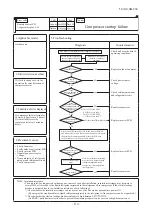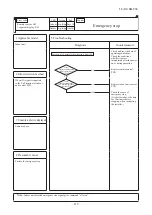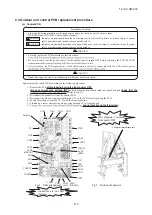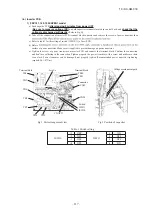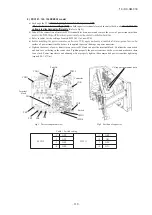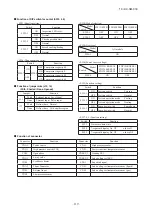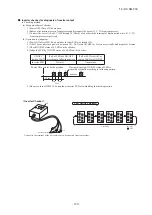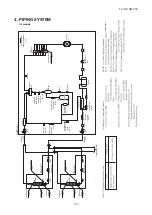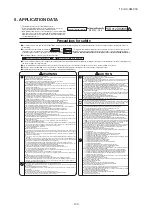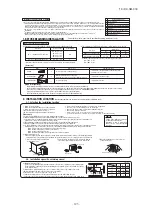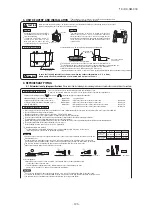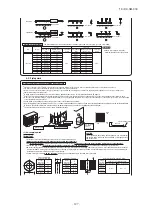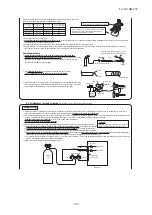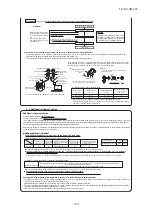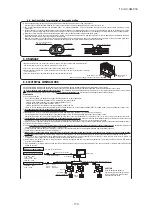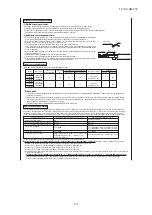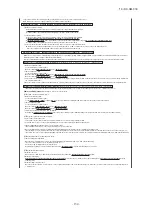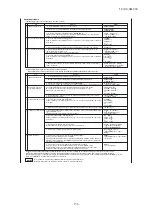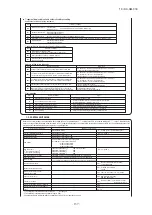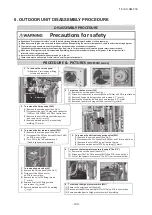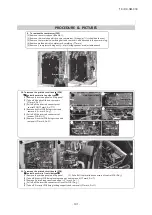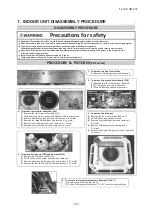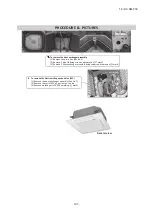
–
128
–
'19 • KX-SM-318
Fix both liquid and gas service valves at the valve main bodies as illustrated on the right,
and then fasten them, applying appropriate fastening torque.
Tightening angle
(
°
)
Tightening torque
(N
・
m)
φ
6.35 (1/4")
φ
9.52 (3/8")
φ
12.7 (1/2")
φ
15.88(5/8")
14
-
18
34
-
42
49
-
61
68
-
82
45
-
60
30
-
45
30
-
45
15
-
20
150
200
250
300
Use a torque wrench. If a torque wrench is not available,
fasten the flare nut manually first and then tighten it
further, using the left table as a guide.
Recommended length
of a tool handle (mm)
Service valve size
(mm)
Do not hold the valve cap area with a spanner.
●
Do not apply any oil on a flare joint.
●
Blazing must be performed under a nitrogen gas flow
. Without nitrogen gas, a large quantity of foreign matters (oxidized film) are created, causing a critical failure
from capillary tube or expansion valve clogging.
●
Brazing of the service valve and the pipes should be performed while cooling the valve body with a wet towel.
●
Perform flushing. To flush the piping, charge nitrogen gas at about 0.02MPa with a pipe end closed with a hand. When pressure inside builds up to a sufficient
level, remove the hand to flush. (in flushing a pipe, close the other end of the pipe with a plug).
Plug the end of the pipe with tape, or other
material, and fill the pipe with nitrogen gas.
Only use nitrogen gas (N
2
)
Taping
<
N
2
>
Nitrogen
Brazing
Brazing
Flatten
Adhesive tape
Station valve
Primary side
Secondary side
0.02MPa
Hand
Relief valve
Nitrogen
gas
Operation procedure
①
During the pipe installation at site, keep the service valves shut all the time
.
②
Blazing must be performed under a nitrogen gas flow
. Without nitrogen gas, a large
quantity of foreign matters (oxidized film) are created, causing a critical failure from
capillary tube or expansion valve clogging.
③
Give
sufficient protections
(compressed and brazed or with an adhesive
tape)
so that water or foreign matters may not enter the piping
.
④
Perform flushing. To flush the piping, charge nitrogen gas at about 0.02MPa with a pipe
end closed with a hand. When pressure inside builds up to a sufficient level, remove the
hand to flush. (in flushing a pipe, close the other end of the pipe with a plug).
Nitrogen
gas
①
Although an outdoor unit itself has been tested for air tightness at the factory, please check the connected pipes and indoor units for air tightness from the check
joint of the service valve on the outdoor unit side. While conducting a test,
keep the service valve shut all the time
.
②
Since refrigerant piping is pressurized to the design pressure of a unit with nitrogen gas for testing air tightness, please connect instruments according the drawing below.
Under no circumstances should chlorine-based refrigerant, oxygen or any other combustible gas be used to pressurize a system
Keep the service valve shut all the time
. Do not open it under any circumstances.
Be sure to pressurize all of the liquid, gas pipes
.
③
In pressurizing the piping, do not apply the specified level of pressure all at once, but gradually raise pressure.
a)
Raise the pressure to 0.5 MPa, and then stop. Leave it for five minutes or more
to see if the pressure drops.
b)
Then raise the pressure to 1.5 MPa, and stop. Leave it for five more minutes
to see if the pressure drops.
c) Then raise the pressure to the specified level (4.15 MPa), and record the ambient temperature and the pressure.
d)
If no pressure drop is observed with an installation pressurized to
the specified level
and left for about one day
,
it is acceptable
. When the ambient temperature
changes 1
℃
, the pressure also changes approximately 0.01 MPa. The pressure, if changed, should be compensated for.
e) If a pressure drop is observed in checking e) and a) – d), a leak exists somewhere. Find a leak by applying bubble test liquid to welded parts and flare joints and
repair it. After repair, conduct an air-tightness test again.
④
Always pull air from the pipes after the airtightness test.
To indoor unit
Gauge manifold
Lo
Lo knob
Hi
Hi knob
Service point
(check joint)
Service valve
Liquid pipe
Gas pipe
Outdoor unit
CAUTION
Applying excessive pressure can cause an
inflow of nitrogen gas into an outdoor unit.
Air tightness test
4-3. Air tightness test and air purge
(Carry them out according to the following steps.)
Summary of Contents for FDC121KXZEN1
Page 159: ... 158 19 KX SM 318 ...
Page 161: ... 160 19 KX SM 318 ...
Page 162: ... 161 19 KX SM 318 ...

